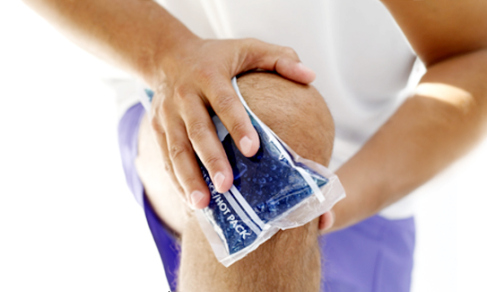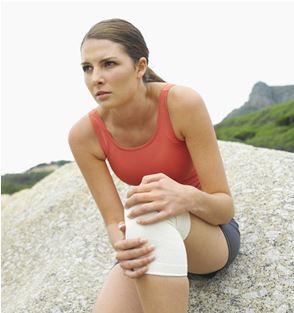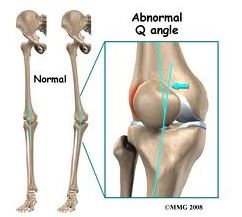7 minutes reading time
(1455 words)
Patellofemoral Pain Syndrome: Symptoms and Treatment for the Most Common Cause of Knee Pain
 When it comes to “being fit” we automatically think of eating right and exercising. We join a gym or enroll in a class with the hopes of achieving the coveted washboard abs all the while never giving the joints of our body a second thought. But, being fit has much more to do with total health of the entire body than it does with fitting into skinny jeans.
When it comes to “being fit” we automatically think of eating right and exercising. We join a gym or enroll in a class with the hopes of achieving the coveted washboard abs all the while never giving the joints of our body a second thought. But, being fit has much more to do with total health of the entire body than it does with fitting into skinny jeans.
Perhaps you had a heavy leg workout one day or you decided to start running more than usual to squeeze in more cardio, only to be greeted with an aching, sometimes sharp pain at the front of the knee. The pain is minimal at first so you decide to work through it but after several weeks the pain continues to worsen and reminds you of its presence each time you take a flight of stairs. You label yourself as having “bad knees” and forgo any and all exercise indefinitely.
Knee pain is one of the more common ailments of the active exerciser. There are a variety of reasons that one might experience knee pain including obvious trauma such as a fall or accident, or arthritis caused from an old high school injury. We’re going to take a closer look at the most common and most treatable knee pain known as Patellofemoral Pain Syndrome (PFPS).
|
Patellofemoral Pain Syndrome (PFPS) is a generic term used to describe pain at the front of the knee which comes on gradually with symptoms increasing over a period of time. |
Symptoms:
- Aching pain in the knee joint, particularly at the front, around and under the patella.
- Tenderness along the inside border of the kneecap.
- Swelling sometimes occurs after activity.
- Pain is often worst when walking up or down hills or stairs.
- Sitting for long periods may be uncomfortable. This is known as the theatre sign or “movie-goers knee”.
- Tight muscles including calf muscles, hamstrings, quadriceps and iliotibial (IT) band.
Causes:
Overloading - Bending the knee increases the pressure between the patella and the femur. Thus sports such as running, where repeated weight-bearing occurs, may result in PFPS.
 Pronating Feet – Pronating, when your feet roll in, or 'flat' feet lead to an increased biomechanical stress on the knee joint. This may affect the alignment of the patella particularly during movement.
Pronating Feet – Pronating, when your feet roll in, or 'flat' feet lead to an increased biomechanical stress on the knee joint. This may affect the alignment of the patella particularly during movement.Q-angle - Some people have a larger than normal femoral angle (known as the Q-angle) resulting in a 'knock-kneed' appearance. When the person straightens their leg when weight bearing, the patella will be forced to the outside of the knee. With repeated bending and loading, this motion may lead to damage of the underlying structures and cause pain.
You will be more prone to PFPS if:
-You have a small kneecap or one that sticks out
-Your feet roll in or pronate.
-You suffer with tight muscles, especially a tight IT band and/or lateral structures.
-You have weak quadriceps muscles (specifically vastus medialis obliquus).
-You are an athlete who does a lot of long distance running or hill running.
-You have had a previous knee dislocation
-You are wearing old or improper footwear
Treatment:
Rest- Taking some time off from running and your leg workouts might be the right thing for a few days up to a couple weeks. Though, it’s not wise to completely stop working out all together. You still have arms and abs—there are plenty of exercises you can do for these areas with zero impact on the knees. Exercise is a key component for managing weight and keeping the joints lubricated—both major benefits to the knees. Plus there are several non-impact physical therapy exercises that work to strengthen weak areas surrounding & supporting the knee joint.
Ice- Yes, plain ole ice is one of the MOST effective anti-inflammatory treatments around. Even the professional football players with all their millions of dollars still take ice baths after their games. Now I’m not recommending an ice bath, thank God, but I can’t stress the importance of icing your knees every single day when you suffer from PFPS. Standard icing protocol is to cover the whole joint for 20 minutes. Repeat every couple hours when pain is present. Remember to never place ice directly on skin—always have a towel or cloth between the ice pack and your skin.
Arnica (Arnica Montana)- Available at Whole Foods, apply topically (cream) to affected/painful area and over any bruised area, it is an anti-inflammatory and pain reliever. When you are active, this is something that will be good for you to keep in your medicine cabinet because it’s great for any trauma, sprain, strain, soreness, or bruising. If you talk to the people at Whole Foods, they’ll show you which one will be best for you, then follow the product instructions on the label.
Epsom Salt- Available at the market near first aid supplies, it’s good for relieving sore muscles, flushing toxins out of the system, and it’s an anti-inflammatory. Add 2 Cups to a warm bath, soak for at least 12 minutes 3x week while knee pain is present.
Curcumin- Available at any health food store, this is the same spice that is in curry (Turmeric), available in capsule form. This antioxidant is a great systemic anti-inflammatory and is effective against joint and circulatory inflammation. The maximum effectiveness of this herb is seen after taking for several weeks, but some studies have even shown it to be helpful after one dose with results comparable to over the counter non-steroidal anti-inflammatory drugs (NSAIDs) like ibuprofen. Follow the instructions on the product label (there are different potencies in each brand) and take the maximum amount recommended for that product. Curcumin is poorly absorbed so it’s hard to over do it, thus the recommendation for the max dose.
Additional “cures” for knee pain:
Proper warm up and cool down - Skipping a warm up is detrimental to the body as the whole purpose of the warm up is to prepare the muscles and the nervous system for the load of this is the number one thing you can do to prevent injuries.
Foam rolling - This can be done as part of your warm up and is a vital link in keeping your knees and joints9 times out of 10 the regular and proper use of a foam roller will prevent all patellofemoral pain.
Proper footwear - If your shoes are more than 6 months old, it’s time for new, often times our feet roll in (pronate) which is another cause for patellofemoral pain. This causes similar mal-tracking of the knee as the hip bone, but is caused from the ground up. But, don’t just run out and buy any shoe that looks good. Visit a store that specializes in proper fitting and foot mechanics for exercise. Some stores, like Future Track in Agoura Hills offer state of the art motion analysis free of charge that will explain how your foot reacts to your body weight, and how that affects your workout. (Note: If you are a runner, you should have a separate pair of shoes designated specifically for running. You will develop certain wear patterns when running compared to cross training which will affect how the shoe functions on your foot and ultimately affects your knee.)
Strengthen Weak Muscles - Just as a tight IT band will pull the patella “off track”, a weak muscle will also do the same by not “splinting” the joint to keep it in proper alignment. Strengthening the abductors, quadriceps, and lateral rotators of the hip can be beneficial when a wide Q angle is thought to be a contributing factor.
Proper Form - Without proper form, exercise can be ineffective and downright dangerous. Be sure that your knee never crosses over your toes when doing squats . Also, be sure to stay off of your toes when doing leg exercises including squats, lunges, jump squats, lateral movements, step ups, burpees, etc. Though your toes will be in contact with the ground, you never want to roll up on or push with your toes. Be sure to keep your whole foot flat and push up through center of your foot toward the heel.
Caring for your joints is equally as important as minding your waistline. Invest in your whole body by including these knee-saving tips and you’ll enjoy a long, active, pain-free journey!
If you experience sudden onset of knee pain after a fall or twisting and/or it is accompanied by a “pop”, bruising, or severe swelling, please see your orthopedic physician immediately as these symptoms are not congruent with the PFPS symptoms discussed in this article.
Related Posts
Comments
No comments made yet. Be the first to submit a comment

